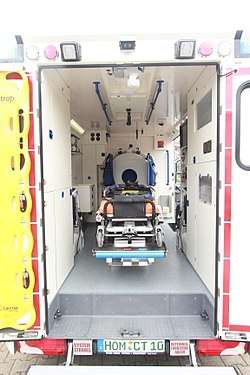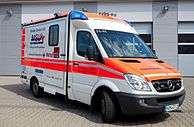Mobile stroke unit
A mobile stroke unit is an ambulance that furnishes services to diagnose, evaluate, and/or treat symptoms of an acute stroke.[1] It may contain, in addition to the normal ambulance equipment, a device for brain imaging (computerized tomography), a point-of-care laboratory and telemedical interaction between ambulance and hospital (videoconferencing, exchange of videos of patient examination and CT scans). Thus, this specialized ambulance includes all the tools necessary for hyperacute assessment and treatment of stroke patients and diagnosis-based triage directly at the emergency site.

Purpose

According to the 'time-is-brain' concept in acute stroke, recanalization of the obstructed blood vessels has to be performed within the very first hours after symptom onset. However, patients mostly come too late to the hospital and, therefore, only a minority of patients (5-10%) obtains the time-sensitive recanalizing treatments, and if so, mostly too late.[2] As a potential solution to the problem of detrimental delays in stroke management the Mobile Stroke Unit concept was developed enabling diagnosis and treatment directly at the emergency site as opposed to awaiting the patient's arrival at hospital for treatment. Apart from the earlier start of treatment, knowledge about the type of stroke already in the pre-hospital phase of stroke management allows accurate triage decisions in regard to the most appropriate target hospital, e.g., hospital with or without endovascular or neurosurgical treatment options.
History and current evidence
The Mobile Stroke Unit concept was first published in 2003 and realized in clinical practice in 2008 by Fassbender et al. at Saarland University, Germany, adhering to current guidelines and legislations.[3][4][5] This strategy of "bringing the hospital to the patient" strongly reduced time between alarm and therapy, allowing diagnosis-based triage to the appropriate target hospital and other novel option such as diagnosis-based blood pressure adjustment.[6] It increased treatment rates and improved care of cerebral hemorrhage, when compared to conventional in-hospital care as shown by them and other groups at Berlin, Germany; Houston, Texas, USA; Cleveland, Ohio, USA; or Drøbak and Oslo, Norway.[7][8][9][10] In 2016, more than 20 sites are investigating this concept. Further studies on long-term outcomes, cost-effectiveness and best setting are underway.
Frazer, Ltd. a Houston, TX based emergency vehicle builder, designed and built the 1st mobile stroke unit in the United States in January 2014. Their specialization in on-board generators for EMS vehicles made them the perfect fit to create an emergency vehicle that could handle the needs of a mobile CT scanner. NeuroLogica Corporation, a subsidiary of Samsung Electronics, provides the mCT, CereTom, enabling the ambulance to do critical CT scans to determine the status of the stroke. With input from leading neurologists, Frazer was able to build a functional space on wheels that helps to drastically cut down the time between onset symptoms and treatment.
In 2016 NewYork–Presbyterian Hospital purchased and fielded the first mobile stroke unit on the east coast of the Unites States [11] and as of 2018 is only Hospital in the United States to field three such units.[12] NYP-EMS operates 3 mobile stroke units based in Manhattan, Brooklyn, and Queens.
References
- https://www.gpo.gov/fdsys/pkg/FR-2018-07-27/html/2018-14985.htm
- Yong E. First response: race against time. Nature 2014; 510 (7506): S5. doi:10.1038/510S5a. PMID 24964025.
- Walter S, Kostpopoulos P, Haass A, Helwig S, Keller I, Licina T, Schlechtriemen T, Roth C, Papanagiotou P, Zimmer A, Viera J, Körner H, Schmidt K, Romann MS, Alexandrou M, Yilmaz U, Grunwald I, Kubulus D, Lesmeister M, Ziegeler S, Pattar A, Golinski M, Liu Y, Volk T, Bertsch T, Reith W, Fassbender K. Bringing the hospital to the patient: first treatment of stroke patients at the emergency site. PLoS One 2010; 5 (10): e13758. doi:10.1371/journal.pone.0013758. PMID 21060800. PMC 2966432.
- Gensic A, Pancioli A. Prehospital and emergency department care of the patient with acute stroke. In Grotta JC, Albers GW, Broderick JP, Kasner SE, Lo EH, Mendelow AD, Sacco RL, Wong LKS, editors. Stroke: pathophysiology, diagnosis, and management. USA: Elsevier; 2016. p. 809–825 (specifically p. 814).
- Hildegard Kaulen. "Notfallmedizin: Zeit sparen beim Schlaganfall". Frankfurter Allgemeine Zeitung (Frankfurt am Main, Germany), 14 May 2012. Retrieved 29 April 2016.
- Balucani C, Levine SR. The "almost magical" mobile stroke unit revolution. Neurology. 2012;78(23):1809-10. doi:10.1212/WNL.0b013e318258f845. PMID 22592365
- Fassbender K, Balucani C, Walter S, Levine SR, Haass A, Grotta J. Streamlining of prehospital stroke management: the golden hour. Lancet Neurol 2013; 12 (6): 585–596. doi:10.1016/S1474-4422(13)70100-5. PMID 23684084.
- Rajan S, Baraniuk S, Parker S, Wu TC, Bowry R, Grotta JC. Implementing a mobile stroke unit program in the United States: why, how, and how much? JAMA Neurol 2015; 72 (2): 229–234. doi:10.1001/jamaneurol.2014.3618. PMID 25485723.
- Audebert HJ, Saver JL, Starkman S, Lees KR, Endres M. Prehospital stroke care: new prospects for treatment and clinical research. Neurology 2013; 81 (5): 501–508. doi:10.1212/WNL.0b013e31829e0fdd. PMID 23897876. PMC 3776535.
- John S, Stock S, Cerejo R, Uchino K, Winners S, Russman A, Masaryk T, Rasmussen P, Hussain MS. Brain Imaging Using Mobile CT: Current Status and Future Prospects. J Neuroimaging 2016; 26 (1): 5–15. doi:10.1111/jon.12319. PMID 26593629.
- https://medium.com/upstartcity/mobile-stroke-unit-now-available-in-nyc-via-newyork-presbyterian-d0c7db10e5cb
- https://www.healthcareitnews.com/news/newyork-presbyterian-adds-more-telemedicine-equipped-mobile-stroke-care-vehicles